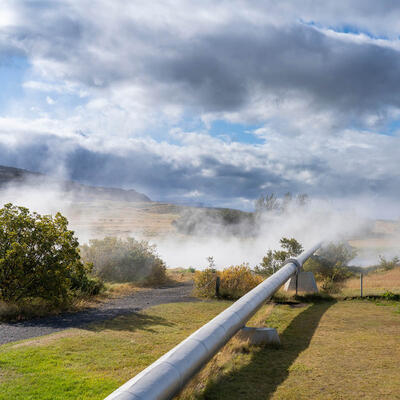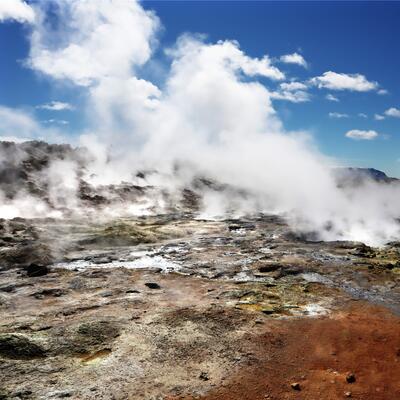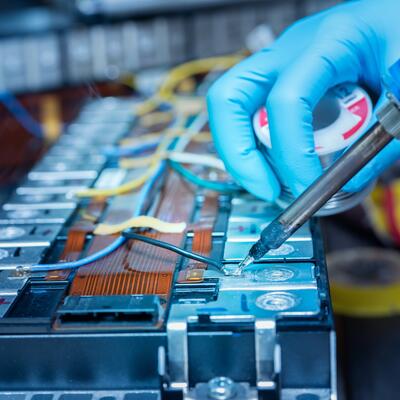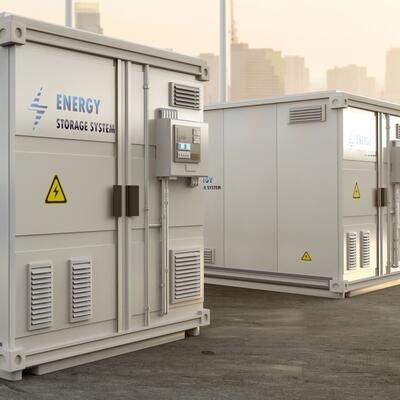
Turning Air into Stone: Tech-Based Carbon Removal
Guests

Marcius Extavour

Angela Anderson

Rachel Glennerster
Summary
The last time the atmospheric CO2 amounts were as high as they are today was more than 3 million years ago. At that time, sea levels were 50–80 feet higher than they are now and temperatures were 2°–3°C (3.6°–5.4°F) higher than in the pre-industrial era. If we stopped burning all fossil fuels today, there still would be enough CO2 in the atmosphere to cause the extreme weather conditions we are already experiencing. This means that not only do we need to stop burning fossil fuels, we need to start removing CO2 from the atmosphere.
We can and should use nature to help draw down atmospheric carbon, but according to Angela Anderson, Director of Industrial Innovation and Carbon Removal at the World Resources Institute, that may not be enough.
“Nature based solutions are an essential part of the carbon removal budget as it were. And I don't think we can even start a conversation about removals without acknowledging that emission reductions are the number one priority. But after, I think the challenge with carbon removals with natural solutions is that while they are an excellent source of sequestering carbon, they are also subject to the same impacts of climate change as we are. The wildfires for example, and the pests that are attacking the forest threaten to make them more of an emitter of carbon than a carbon removal source. So, we have to tackle that and invest in technology at the same time.”
So how do carbon removal technologies work? Marcius Extavour, VP of Energy and Climate at XPRIZE, explains that the leading contenders still take their inspiration nature - for example, from how trees filter the air:
“You could copy what plants do and build some of that function into a machine. Think of like a HEPA filter that just sits outside. The air goes in one side; regular air comes out the other side except the CO2 that’s in trace amounts in the air gets stripped out. And that, you know, kind of will probably look like an industrial facility like a small industrial plant. …There’s another method which is to again copy nature, but this time copy the minerals. The White Cliffs of Dover is a giant chalk deposit. And chalk is a carbon-containing mineral and this forms naturally by the interaction of rocks and the air over millions of years. So, just like with the direct air capture you say okay let’s study what the plant does, see if we can increase the efficiency. Let’s study what rocks do, see if we can increase the efficiency.”
Global capacity for carbon removal right now is around 40 million tons, but the IPCC estimates we need to be removing as much as 10 billion tons every year. One reason we’re so far behind may be that a sufficient financial incentive doesn’t yet exist. An “advance market commitment” could be used to create that incentive. Basically, that means if I build it, you’ll buy it, at a price agreed upon ahead of time. Rachael Glennerster, an Associate Professor of Economics at the University of Chicago, is one proponent of this idea.
“We can suck carbon out of the air in this really good way and the financial market is gonna go, yeah, but like who’s gonna buy that? How are you gonna make any money from that? So, it’s not really a surprise that we don't have a range of really good alternatives at scale because there's no market for it. We need to say well, we can solve that problem because we can't know exactly which of these technologies are going to pan out, but we can say that if you manage to produce it, we would buy it. Because we know that it's valuable to the world to produce this.”
Related Links:
Full Transcript
Greg Dalton: This is Climate One. I’m Greg Dalton. New technologies hold promise for pulling carbon emissions out of the atmosphere.
Marcius Extavour: Things designed by humans tend to be more energy intensive than things designed in nature. It's also roughly true that things that humans design tend to be a little more efficient than things that are designed in nature.
Greg Dalton: But we also have to find ways to incentivize carbon removal.
Rachel Glennerster: We can suck carbon out of the air in this really good way and the financial market is gonna go, yeah, but like who’s gonna buy that? How are you gonna make any money from that?
Greg Dalton: The reality is we need to employ all the tools we have to help mitigate the climate crisis.
Angela Anderson: I don't think the moral hazard is quite as compelling as it would have been say a decade ago when these climate impacts were not so obvious. And it wasn't so clear that we just cannot continue to live in a world powered by fossil fuels.
Greg Dalton: Tech-Based Carbon Removal. Up next on Climate One.
Greg Dalton: I’m Greg Dalton. The last time the atmospheric CO₂ amounts were as high as they are today was more than 3 million years ago. It’s obvious we need to stop emitting greenhouse gasses, but that won’t be enough to prevent adverse effects of climate disruption because of how much carbon we’ve already put into the atmosphere. According to the IPCC, we need to remove approximately 10 gigatons of CO2 per year by 2050 in order to keep global temperature rise under 2°C. With forests burning faster than we can grow them, nature-based solutions may not be enough. Today we explore why we need technological solutions in addition to nature-based ones. My guests are Marcius Extavour, VP of Energy and Climate at XPRIZE and Angela Anderson, Director of Industrial Innovation and Carbon Removal at World Resources Institute:
Angela Anderson: Nature based solutions are an essential part of the carbon removal budget as it were. And I don't think we can even start a conversation about removals without acknowledging that emission reductions are the number one priority. But I think the challenge with carbon removals with natural solutions is that while they are an excellent source of sequestering carbon, they are also subject to the same impacts of climate change as we are. The wildfires for example, and the pests that are attacking the forest are threaten to make them more of a emitter of carbon than a carbon removal source. So, we have to tackle that and invest in technological at the same time.
Greg Dalton: Yeah, it was gut wrenching to see forests go up in flames, some of those forests or all of them are capturing carbon and some of them were involved in offset programs where economies were counting on them in some big way. Marcius, what do you see as the case for technology over nature or in addition to nature?
Marcius Extavour: I definitely see it as in addition to. The nature-based solutions have their pros and their cons. Same with the technological solutions they’re not perfect they tend to be more expensive. They also tend to be considered more durable in the sequestration part. So, it’s sort of, you know, a crude question is like what's the durability worth to us are we willing to pay more for something that is more effective in some ways or do we want something that’s more accessible, less effective in some ways has other benefits. So, for me I think the answer to the question is having a broader range of solutions to pick from allows different regions to make their own trade-offs on those questions. Because there might not be one answer for every region, every country, every community, some may be willing to pay more for different services others may want to pay less for different types of services rather than try to think there's one best way to do removals, I think we need a mix of different solutions so that they can be applied different places, So, for me that's the case for expanding the search beyond just the technological or just the nature-based or just the oceans or just the minerals and just focus on well doesn't work and how could it be developed.
Greg Dalton: Angela, take us back to when you first heard about carbon removal technology at a conference. What was your reaction?
Angela Anderson: Yeah, so this conference was about three, four years ago. I knew vaguely about carbon removal. I'd spent the last two decades working on phasing out coal plants and ramping up renewables but was getting increasingly dispirited because all those big moments, you know, the Waxman-Markey Bill, potential federal legislation Copenhagen, the potential you know new international agreement that didn't go as planned. And I'm working around these scientists that are telling me that we’re just not reducing fast enough and ramping up renewables fast enough to avert the really catastrophic consequences of climate change. Then I went to this conference and started hearing not only about the nature-based solutions, which they knew about but about these potential technological solutions and that they were more plausible than I had thought that they were up until that point. And the emotion that I felt there was hope. That there are actually more tools in the toolbox than I realized and that we needed to start taking a look at how to get these tools in our hands and work it.
Greg Dalton: Marcius, you touched on kind of the spectrum of technological contenders. Unpack those a little bit. There's direct air capture, there's direct ocean removal, advanced weathering. What are some of the tools there?
Marcius Extavour: So, there's one style where you do the mechanical tree as you said you basically do what plants do and, you know, crude vision of a plant is it kind of filters the air and takes the nutrients that it needs in this case the carbon dioxide. So, you could copy what plants do and build some of that function into a machine. Think of like a HEPA filter that just sits outside the air goes in one side regular air comes out the other side except the CO2 that’s in trace amounts in the air gets stripped out. And that, you know, kind of will probably look like an industrial facility like a small industrial plant. There’s another method which is and that method is usually called direct air capture, There’s another method which is to again copy nature, but this time copy the minerals. The White Cliffs of Dover is a giant chalk deposit. And chalk is a carbon containing mineral and this forms naturally by the interaction of rocks and the air over millions of years. So, just like with the direct air capture you say okay let’s study what the plant does, see if we can increase the efficiency. Let’s study what rocks do see if we can increase the efficiency. Maybe we spread the rocks around. Maybe we add chemicals to the rocks. Maybe we just cause the CO2 to flow over the rocks faster. So there’s various tricks and techniques people are studying there. And I’ll just hit two more other buckets. One is everything to do with the oceans. This could be filtering seawater because about a third of our CO2 emissions end up dissolved in seawater. I think this is something we always forget. We think it’s on the air, but the huge amount of it dissolved in the ocean. So, you could de-solve it, take it out de-sorb it or you could stimulate plant growth and ecosystem restoration in the oceans. It could be fish, whales, plants, even kelp, things like that. Things that naturally feed on CO2 phytoplankton, algae, and they'll want to consume that CO2 out of the seawater that means you’re taking CO2 out of the seawater. And then the last technique is what we started at with the nature-based plants, trees, soils, something called biochar, which is made from plant material and can be a fertilizer, a soil additive.
Greg Dalton: When you mention HEPA filters that was something I could understand particularly having those because of the wildfires here in the West. I also know that you're forcing air through a membrane takes a lot of energy. So, can you discuss some of the pros and cons of these tools in the toolbox, such as energy usage?
Marcius Extavour: Exactly right. So, some of them are passive. Some of them are active. So, we want to force the air through that direct air capture device using a fan and a motor that powers the fan and that motor is gonna draw electricity, maybe a lot of electricity. Those systems usually sometimes take heat to help separate the CO2 from the compound that catches it out of the air so that takes more energy. So, it’s a fair thing to say that things designed by humans tend to be more energy intensive than things designed in nature. This is one of the things that nature is extremely good at optimizing for. It's also roughly true and this may be an inconvenient truth, it’s also roughly true that things that humans design tend to be a little more efficient than things that are designed with nature. That’s not universally true okay, but again it comes down to well, how much it’s gonna cost and how much land is it gonna take up and is it the type of thing that people will hate. And therefore, not really be a good idea to try to install on the community or is this type of thing that provides other benefits. What does the public perceive as the relative value of CO2 removal and fighting climate change versus other things like increasing crop yields or restoring wetland or protecting a coast from flooding or preserving biodiversity and ecosystem or cleaning up mine tailings like, when you frame it in those terms I think it starts to get a little more relatable rather than sort of a weirdo abstract concept of why are we filtering this gas and why is it in the air and what’s the point of it again?
Greg Dalton: Angela, the Infrastructure Act allocates 3 1/2 billion dollars to direct air capture hubs. How do you think that should be invested and how will it impact direct air capacity?
Angela Anderson: The Department of Energy is doing a great job right now putting out requests for information asking folks how should we implement this law. So, it'll be interesting to see how people respond to the direct air capture question. They had some terrific prompts saying how do we promote direct air capture and engage communities in doing that. How do we make sure that the benefits of this facility are distributed to the surrounding communities and how to make sure that they're not harmed by it. So, I think that’s gonna be a really important and somewhat new development when we think about how to site these facilities.
Greg Dalton: Yeah, Marcius there’s a real thing there about you know, Canada and the United States industrialized, countries in the north have quite a legacy of putting large industrial facilities in neighborhoods where people don't have a lot of power, often communities of color. How do we know that this won't be the same. These big, I’m gonna say these mega HEPA filters they’re gonna suck carbon out of the sky. What's in place to prevent environmental racism from continuing?
Marcius Extavour: I think the real answer is nothing. Unless we make something happen in place. So, if we do nothing if we don't talk about this then it'll happen again. The reason it happens I think is for many reasons, but one of them is it just seems simpler at the time for the project developer to do it that way. Community consultation takes work. The argument is, a stitch in time saves nine, you know, that ancient expression. If we do a little work now, we’ll save a lot of pain later. It's also the right thing to do. So, for me, we have to have these conversations so that we can develop methods so that we ensure it doesn't happen again. Because if there's one thing I do know it's that this won't work if people perceive that it's not helpful to them or that they are being taken advantage of. People aren’t dumb; they get this. So, it's up to us to explain what the idea is. It's up to every project developer to think about engagement strategies. So, I think it’s important to be real that there’s no foolproof way to do this aside from kind of just doing the work and not skipping the steps.
Greg Dalton: Marcius, the Climeworks Orca plant has received a lot of attention. It's cited in Iceland where it could be co-located with existing geothermal facility as well as where the underlying rock is suitable for mineralization of the captured CO2. It's a pretty special spot there in Iceland. How plentiful are comparable locations?
Marcius Extavour: I think the answer is fairly plentiful. So, finding a location where you can do the direct air capture in the way that the Orca plant does is pretty easy because the advantage of direct air capture is well the air is everywhere and you can do it just as well here or there. It really comes down to, you know, what's an appropriate community. In Orca they’re doing it in a fairly remote spot as I understand. But it also is on top of a really helpful rock feature because they're taking the captured CO2 once it’s purified out of the air, injecting it underground into a rock that will, like my White Cliffs of Dover analogy, eventually itself turn into rock over time so you inject it. But those types of geological sites are not rare at all. There are a lot of places we can do them. So, even if we want to, I think we should constrain ourselves to asking questions like where is that technically appropriate site, where is a low-cost site, where is a convenient site where is a good place to build, where is a place that the community will accept this project. Even when we go through those filters. We don't narrow out, you know, we still have plenty, plenty of site options. So, I am not worried about siting and finding locations being the issue I'm worried more about finding the right sites and actually the technical and social buildout of the system.
Greg Dalton: How about jobs? Jobs often come up in this, you know, there’s construction jobs and permanent jobs. So, this big HEPA filter can see a lot of jobs constructing it, but how about permanent jobs?
Marcius Extavour: It’s a little bit similar to a power plant or a factory in the sense that there’s a lot of job creation in the construction phase. But then to operate it you need a much smaller workforce. Probably dozens of people type of thing to operate a large facility. Notably, I think the labor needs and opportunities can be quite dramatically different with different types of carbon removal approaches. So, for instance if you're talking about ecosystem management or preserving or reforesting or aforesting a forest so to speak, planting trees, maintaining them make sure they’re not logged inappropriately. That is just a little more labor-intensive and over a more consistent period of time. I think another way to think about job creation opportunities is not just this drop-in box or project that does CO2 removal alone, but a CO2 removal project that does other things.
Greg Dalton: You’re listening to a Climate One conversation about tech-based carbon removal. Our podcasts typically contain extra content beyond what’s heard on the radio. If you missed a previous episode, or want to hear more of Climate One’s empowering conversations, subscribe to our podcast wherever you get your pods. Coming up, can we trust that companies won’t use carbon capture technology as an excuse to continue business as usual?
Marcius Extavour: We’d like to see your commitment to reducing your existing emissions on one side of a ledger. And we’d like to see your commitments to carbon removal on another side of the ledger. Because they’re really not the same thing.
Greg Dalton: That’s up next, when Climate One continues.
Greg Dalton: This is Climate One. I’m Greg Dalton, and we’re talking about technological approaches to pulling carbon dioxide out of the sky. Before continuing our conversation about carbon removal, we want to touch on another important process, methane capture - preventing this potent greenhouse gas from leaking into the atmosphere in the first place. For nearly a decade, a small operation on Colorado’s Western Slope has been ahead of the curve: it’s captured methane from abandoned coal mines and put it to use. As Stephanie Maltarich reports, what started as a business venture has evolved into a larger campaign to remove methane in areas of Colorado rich in coal mining history.
Stephanie Maltarich: On a cold January afternoon, Chris Caskey drives his small truck up a windy dirt road into the hills above Somerset, Colorado. The road climbs over a former coal mine that officially shut its doors in 2015.
Chris Caskey: “So the mine is below us a few hundred feet, this was the ventilation facility…”
Stephanie Maltarich: The facility looks and sounds like any other coal mining operation: chain link fences line the area complete with no trespassing signs and industrial shipping containers that house the rumbling generators. But it’s actually quite the opposite: instead of leaking methane from the grounds below, Methane Rx, a company that captures methane from abandoned coal mines in Colorado and Pennsylvania, keeps it from escaping into the sky.
Chris Caskey: “In here is the methane gathering system, so all the methane that we're collecting here would be getting out to the atmosphere through different gaps and cracks in the mines. But instead, we got a pipe a couple miles underground. We’re sucking gently on that pipe. And these are the motors and pumps here. Pulling the gas from underground, sending it to the generators over there.”
Stephanie Maltarich: Caskey is a chemist and the managing director of Methane Rx. Before this Colorado mine closed, a former oil and gas exec launched the project, selling the methane to produce electricity to power lifts at Aspen Ski Company on the other side of the mountains. Methane Rx is the only facility capturing methane and converting it to electricity in Colorado, and one of a few in the U.S. This region of rural western Colorado has been mined continuously since the late 1800s. But in the last decade, all but one coal mine have closed. Caskey sees potential for a new industry here – an area littered with abandoned coal mines that leak methane, an invisible gas, quietly into the air.
Chris Caskey: “You can actually see a methane vent, the methane is hot and humid, water vapor hits the cold air and condenses and you can see it…”
Stephanie Maltarich: Methane is a greenhouse gas that in a period of 20 years, has 80 times the warming potential of carbon dioxide, and methane from coal mines makes up almost 10% of U.S. methane emissions. Raymond Pilcher is the president of Raven Ridge Resources, Incorporated, a Colorado-based consulting company that has worked to curb methane emissions from coal mines since 1989.
Raymond Pilcher: “So it's really important that as we move through this whole process of closing mines to recognize that methane doesn't just magically go away.”
Stephanie Maltarich: Pilcher is now part of the "Group of Experts on Coal Mine Methane and Just Transition," an advisory group of the United Nations Economic Commission for Europe. The group creates best practices and recommendations for capturing and monitoring coal mine methane. Pilcher applauds operations like Methane Rx, and also believes we need new international standards that help communities transition when mines close.
Raymond Pilcher: “In mines that are very gassy, a lot of the times the closure modes are not actually aligned with closing that mine in such a way that you can easily get the gas out. And so, when you are talking about a just transition and getting back to work and taking care of the communities etc. all of these things get tied together.”
Stephanie Maltarich: Between the facilities in Colorado and Pennsylvania, Methane Rx currently captures a million cubic feet of methane each day, which is equivalent to tens of thousands of vehicles in terms of climate pollution. Managing director Chris Caskey says the company plans to expand its efforts this year, in line with national and global efforts.
Chris Caskey: “Only recently has the US or our society got serious about climate change. And even more recently, we've realized collectively that methane is a huge problem. So with that motivation, we're looking towards getting several other projects going in the next few years.”
Stephanie Maltarich: Last November, 111 countries pledged to decrease methane emissions 30% by 2030 at COP26. Later that month, The Biden Administration released the U.S. Methane Emissions Reduction Plan, which aims to reduce pollution nationally from the highest sources of methane emissions. Caskey admits there are barriers to more coal mine methane capture, including a lack of federal regulation and incentives. But with new federal legislation in the works, capturing more of this dangerously potent gas may get a little easier. For Climate One, I’m Stephanie Maltarich.
Greg Dalton: While preventing greenhouse gasses from entering the atmosphere remains critical, now let's continue our conversation with Marcius Extavor of XPRIZE and Angela Anderson of the World Resources Institute about how to remove what’s already in the air. The Climeworks Orca plant is an early-stage carbon removal project. Their current cost is estimated to be around $600 per ton of carbon dioxide removed, whereas natural carbon removal like reforestation costs less than $50 a ton. But Marcius Extavor says he’s pretty confident that costs can come down on direct air capture quickly enough to make it competitive.
Marcius Extavour: What gives me confidence despite the complexities and the sort of strangeness of the idea of direct air capture. The technology is fairly simple. And that's with full credit to Climeworks, Global Thermostat, Carbon Engineering, many other groups out there working on this. It's much simpler than many other types of technologies that we as humans have scaled up and brought cost down much, much more quickly. I mean, for instance, compared to your iPhone or your cell phone is a much less detailed and complex technology. We know how to bring costs down for this type of thing through industrial development. We've done it many times before in various technologies. The basic challenge to bringing the cost down is, is there enough market demand, you know, to make the cost go down, you’ve got to build another larger Orca. Someone's gotta finance that. When you ask the financier for money, they’re gonna say well who are your customers going to be? Show me that you have revenue five years from now to backstop the loan. And that part is still squishy. So, we’re still trying to generate customers we’re trying to generate supply to feed this market at the same time we’re trying to bring the cost down.
Greg Dalton: One market problem also is that there is the most lucrative use for capturing CO2 is enhanced oil recovery where CO2 was pumped into nearly played-out wells. The fossil fuel industry says they're sequestering carbon which maybe they are but they're also doing that in a way that produces more oil and gas which ends up emitting more CO2. Angela, how can we make carbon removal pay in a climate positive way?
Angela Anderson: The enhanced oil recovery is one way to create a customer as we were just talking about for the carbon removal, but I think the ideal policy would be temporary. That is both it's a start up for the direct air capture industry, but only long enough for that market to develop. And so, you have a phaseout of the enhanced oil recovery from you know use of the carbon long enough to again get the new industry up and running but to continue phasing down fossil fuels. Fossil fuels aren’t gonna go away overnight. And so, for us to be able to again utilize this known technology while we build out more underground storage facilities for example. And it's really important to look at other utilization opportunities for this captured carbon. There are some really innovative entrepreneurial companies that are looking at ways to create aviation fuel for example, out of captured carbon. Lots of other products like, can you add it to cement or other building materials like carbon fiber, for example. There are some issues around the permanence of those particular products that we have to take into account but some would tell you that there is a whole potential marketplace in using that carbon that gets captured not just burying it. It’s still a fraction of how we need to use it most likely, but I think it can play an important role.
Greg Dalton: 8% of global CO2 emissions is from cement. What is the potential you see, Marcius, for developing carbon-negative technologies as products and can they be commercially viable?
Marcius Extavour: Easy answer, yes, they could be commercially viable and some of them actually exist today. So, Angela mentioned some of them. I’ll start with the concrete one. This is, you know, look, not too many people get excited about concrete.
Greg Dalton: But it’s huge, I mean, it’s a big deal.
Marcius Extavour: No one has ever come up to me at the party and said, let’s talk about concrete. With all respect to like concrete colleagues and stuff. But, you know, it turns out concrete is like our number one building material as human beings. Like the bees make their homes out of wax. Humans make our stuff out of concrete. It’s like what the aliens might say when they land. Oh wow, this civilization is based on concrete. Okay, it's not just sidewalks, it’s airports, bridges, roads all over the place. It happens to be that the world is going through a building boom right now, especially in the Global South. So, guess what? It's gonna be a lot more concrete contracts. And the good news is again the technology to put CO2 into concrete pretty straightforward and it's actually happening commercially today. CarbonCure is one of the leaders here. They have a technology it goes into existing concrete plants to retrofit and they are in I believe several hundred plants around the world now, which means several hundred plants are using their technology to generate lower carbon and stronger and just as you know, just on the same cost basis products. Things like polymers, which is the fancy word for plastics into everything from clothing to shoes, apparel, you know, durable goods, like the desk I’m sitting at. There are companies working on food products. Amino acids into proteins into you know think about something like Whataburger or synthetic meats. You could make those out of CO2 molecules. So, I don't want to over exaggerate where the market’s at. There are a lot of great ideas that are getting commercial as Angela said from the climate perspective these things are important, but they don't add up to what we need, not even close. But for me the real value is they generate revenue. Imagine you’re an early stage startup trying to get your social good project off the ground, this carbon removal project. Today the economy says it's not really worth anything. And so, they’re trying to generate a way to move forward. This is the reason people partner with enhanced oil recovery projects by the way, it's a guaranteed source of revenue. And that's what you need to stay alive if you’re an early stage technology developer. The way we get off of that as Angela says is to make sure it doesn't become a crutch forever, but also have a plan to transition off it. And I think it's up to the rest of us. One way to look at it is to say well, the enhanced oil recovery community has stepped up and it said we’ll take your product and we can pay you for it. Great, someone is going to make a better offer and say I’ll take more of your product and I’ll give you a better price. That's how we establish a roadmap to move past these things. So, I think these products are fantastic. They get people talking, they can generate revenue. Their climate benefit is limited, but the long-term impact is if they can help these solutions develop and get to the next stage then that will be the win and the products will have been a stepping stone along the way.
Greg Dalton: According to the IEA, the International Energy Agency global capacity for carbon removal right now is about 40 million tons. That sound pretty good, but it's a far cry from the 10 billion tons we need to be capturing per year. Angela, You spent decades as a coordinator and international advocate. How much faith do you have in the international governance process to get that job done?
Angela Anderson: So, the international process is I think really bearing some more fruit than it was when I was more actively involved, let’s say. The next year is gonna be really interesting to see where the countries go in terms of tightening their commitments. If the countries make commitments to get to net zero by a particular time then they have to put those policies in place that will electrify everything we can electrify. That in turn drops the demand for fossil fuels and enables us to again force that business model to change. Low carbon product standards that's another way to again drive that marketplace where companies are looking to reduce the embodied carbon in their products. And again, some of that can create the market for using captured carbon as part of that strategy. Some other tools that I think are really essential are the loans and grants, demonstration projects really testing to see how some of the various approaches to carbon removal like carbon mineralization, especially some of the ocean carbon removals. There's a lot of kind of iterative research that needs to happen to see how viable they are. And so, the governments can play a huge role in that R&D as well as ultimately demonstration and deployment.
Greg Dalton: Marcius, what are some moral hazards associated with direct air capture of carbon and other greenhouse gasses?
Marcius Extavour: I think there's really one and it's the fear that if we focus on carbon removal that will take the pressure off of mitigation. And we started the conversation Angela already pointed out that turning off the taps of emissions are the most important things we can do today and tomorrow and for the next decade. But we know that we’re sort of far enough down this carbon emissions road that we also need separate removals. So, the biggest hazard is confusing the role of removals with the role of mitigation. And I'll take it further and say that, especially when fossil fuel companies start to sniff around, the common reaction is, well, it's in their interest to preserve the status quo in their business model for as long as possible. So of course, they're only interested in this to change as little as possible. If this is like a bolt-on bandage that they can just do then of course they’re gonna want to do that. I think sometimes that's accurate; I think sometimes it’s not accurate but it’s hard to tell. For me, one of the tools we can use to kind of burst the bubble on that moral hazard risk is aside from just saying and promising and holding hands and saying we won’t let that happen is we can say okay anyone that’s doing their carbon accounting I’m talking about a net zero commitment or whatever, we’d like to see your commitment to reducing your existing emissions on one side of a ledger. And we’d like to see your commitments to carbon removal on another side of the ledger. Because they’re really not the same thing. Sometimes people mix them because they’re confused; it’s confusing it’s new, but if you're intentionally confusing them because you'd like to really say you're doing one thing when we’re doing another, that's the problem. So, this has been brought up in some of the science literatures, you know what, let’s just have two accounting standards. This is how much we’d like to reduce our emissions and we don't think we can go past this. And so, then here's also our carbon removal goals. And then everybody can see those and we can treat them in ways that need to be treated. So, for me that’s a good way to mitigate against this hazard.
Greg Dalton: So, clean up your own room first before you go cleaning up around the neighborhood, yeah.
Marcius Extavour: There’s one other thing I wanna add to which is and I think the moral hazard critique is important and really something we need to take to heart and act on. But, you know, risk is always you can’t assess one risk in isolation. You have to assess a risk relative to something else. And right now, we know what the something else is, the something else is what we do now. Something else is the gigantic moral and civilizational hazard of continuing to emit greenhouse gasses at the rate at which we have been now that we know for sure that this is a problem and it’s not gonna end well if we don’t make a change. So, I see the moral hazard of adopting a new set of solutions but we have to weigh that against the risk of doing nothing which is what we’re doing now.
Greg Dalton: We could also see this as a free rider problem where some people say well, I’m gonna let certain rich country solve this or you could say that that's actually good because it’s the rich countries that created this problem so they should pay it. And you know Africa and the Global South should not pay to clean up our mess.
Angela Anderson: I do think the developed world has an obligation to ramp up more around carbon removal. It has the capacity to invest in these higher dollar removal technologies, right. And in fact, we need to do that in our own countries and only in developing countries with their expressed desire and request to help them learn how to do it as well. So, you know, I think that there is the moral hazard is certainly real, but the world is realizing and feeling the effects of climate change right now. And I don't think the moral hazard is quite as compelling as it would have been say a decade ago when these climate impacts were not so obvious. And it wasn't so clear that we just cannot continue to live in a world powered by fossil fuels.
Greg Dalton: Angela Anderson and Marcius Extavour, thanks for coming on Climate One.
Angela Anderson: Thank you.
Marcius Extavour: Thanks for having us.
Greg Dalton: You're listening to a conversation about carbon removal technology. This is Climate One. Coming up, how advance market commitments could boost the industry:
Rachel Glennerster: We want people to be thinking of scale and producing at scale and part of the way of doing that is to say we would commit to buy it on massive scale if you can produce it.
Greg Dalton: That’s up next, when Climate One continues.
Greg Dalton: This is Climate One. I’m Greg Dalton. Global capacity for carbon removal right now is around 40 million tons, but the IPCC estimates we need to be removing as much as 10 billion tons every year. One reason we’re so far behind may be that a sufficient financial incentive doesn’t yet exist. An advance market commitment, or AMC, could be used to create that incentive. Basically, that means if I build it, you’ll buy it, at a price agreed upon ahead of time. Rachel Glennerster, an Associate Professor of Economics at the University of Chicago, is one proponent of this idea. She spoke with Climate One’s Ariana Brocious about how the use of advance market commitments in vaccine development relates to the carbon removal market.
Rachel Glennerster: I was involved in some work to where donors made a commitment to buy the pneumococcal vaccine. A pneumococcal vaccine that was appropriate for low- and middle-income countries and they committed to buy that at very big scale if companies could produce it. Normally what happens when people produce a vaccine is they produce it in a relatively small scale initially just enough to meet the high income market and they charge a high price because they can to a high income market. And then only over time do they expand production and bring it to the rest of the world. But this upfront commitment of saying no, we will buy a lot of that stuff if you manage to produce it at scale. The main thing it did was it really sped up the production at massive scale, and you got the vaccine out to many more people many more quickly. And that's what we want to do with carbon removal. We need it to go very big very fast, as fast as it possibly can. And we want people to be thinking of scale and producing at scale and part of the way of doing that is to say no we would commit to buy it on massive scale if you can produce it.
Ariana Brocious: Right and companies like Microsoft and Stripe have already put a lot of money into some of these projects. There's one in Iceland by Climeworks direct air capture project. Does that count as an advance market commitment or is it something different?
Rachel Glennerster: What Stripe and other people are mainly doing at the moment is buying the output at whatever the current price is for each individual firm. So, they’re making contracts with individual firms to say you know if you produce at your current cost, we will pay you at your current cost. And that's good and that's important and that's useful. What I think it would be great to see in addition is a more open commitment that wasn't firm by firm, was at the market level and said in the future we’re gonna set a price at which we would buy from anyone and will legally commit to buy it at that price from anyone. And that introduces competition between all the different producers of carbon capture and carbon removal. And at the moment donors are having to make contracts with individual firms and they have to pick which technology they think they want to put the money into. And the benefit of an advance market commitment is you don't have to pick which you think is going to be the most promising technology. You in a sense, let that to the market to work out you just say I will buy whichever is the best whoever manages to meet this target in the future. So, I think we probably need both. We need what is currently being done, but we also need a market level commitment that will attract many more people into the industry and really provide that incentive to drive prices down and cost down.
Ariana Brocious: The Iceland project that we mentioned, Climeworks, is removing carbon dioxide at a rate of about 4000 tons per year which really is not very much. It's only equivalent to about 250 average Americans’ emissions. So, do you have a sense that there is a ready and waiting set of innovators that can enter this market and quickly scale and develop new technologies or similar technologies that are just gonna really like expand that beyond one plant if there were these commitments.
Rachel Glennerster: Yeah, so, the answer is we don't know, but we don't know because there's not a market there; nobody knows whether anyone will buy it and therefore nobody is putting in very much investment and therefore there aren’t technologies. So, it’s not really a surprise that they’re aren’t massive technologies because there’s no market for this. I mean, unlike solar electricity where you’re doing something for the environment but you also producing electricity like there’s something that you can actually buy, be of use to you as an individual company. In the case of carbon removal, you’re just doing something good for the world, right? So, you can imagine someone going somebody who has a brilliant idea going to the financial markets and saying you know invest in us. We can suck carbon out of the air in this really good way and the financial market is gonna go, yeah, but like who’s gonna buy that? How are you gonna make any money from that? So, it’s not really a surprise that we don't have a range of really good alternatives at scale because there's no market for it. So, you know we can't give up on this. We need to say well, we can solve that problem because we can't know exactly which of these technologies are going to pan out, but we can say that if you manage to produce it, we would buy it. Because we know that it's valuable to the world to produce this but we don't know exactly what is the right technology now, but we can say if you come up with it we will buy it. And the benefit for it for donors is if nobody manages to succeed, they don't waste any money because nobody has managed to produce the carbon removal. So, in a sense that's a free good like you put your commitment in if it generates great new technologies, then you've done something amazing. If it doesn't, you know you haven’t lost any money.
Ariana Brocious: At least we tried.
Rachel Glennerster: At least we tried. And I mean we really need to try. And I'm pretty confident that you know there are nascent technologies out there as you say they’re very small scale at the moment. But if we put the kind of money that we should be putting behind this. It would get people really seriously thinking about it and you’ll have a lot of really smart people putting a lot of time and effort into doing it. And we know that the innovators are incredibly innovative and we've managed to solve all sorts of problems in the world that have billions of and trillions of dollars of reward behind them. So, I'm pretty confident that this is not harder than you know an awful lot of other things that we've managed to solve. I mean just to go back to the pharmaceutical example again. We see a hell of a lot of innovation for the kinds of diseases where people can pay a lot of money for a solution. And we see much less innovation all in the diseases of the poor world. That's not because they are inherently harder, it's just because there's a big market for one and there isn’t for the other. So, we see innovation where there is a market reward. We need innovation here so we should provide the market reward for it and commit that there will be a market for it.
Ariana Brocious: So, how does this get set up? Who's in charge of organizing these commitments from funders or investors and then making that knowledge, you know, public to these innovators?
Rachel Glennerster: Right. So, what's happened in the past when we've used this mechanism in the past is that a group of people who want to make the commitment get together and draw up a contract which says, you know, this is what success would look like. This is what we’d be willing to buy. And you have to define what's the price that you’d be willing to pay for this, what's the quantity you’re willing to pay and what do you mean by permanent. As I say a lot of the problem in the carbon offset market at the moment is there isn't good regulation or good definition of you know what it actually means to be a high-quality carbon removal product. So, you have to have a group so you know a group of people come together who are willing to put money in and say this is the definition. Okay, this is what I’m willing to buy, this is how much I'm willing to spend and this is what I mean. You have to hit these technical targets to count for me to be willing to buy it. And then you draw, you know, a sort of term sheet of that kind, make a legally binding commitment and as they say this has been possible in the past. I mean there are ways in which government could get involved it doesn't have to involve government it could involve government, it just needs a group of willing interested parties to work together to do it.
Ariana Brocious: Elsewhere in this episode we spoke with Marcius Extavour who’s helping direct $100 million XPRIZE funded by Elon Musk to incentivize new carbon removal technologies. So, from an economics perspective what do you think about prizes as incentives for developing new technology and innovation?
Rachel Glennerster: Yes, so prizes are quite close to a market commitment. So, we make a distinction in the economics of innovation between two types of ways of funding innovation. One is push and one is pull. So, push is where you just give money to an organization to do so, you know you pay for the inputs you give a grant as they say some of the money in those spaces, grant funding. And then a pull mechanism is one that pays for results. So, we’ll pay for something if you manage to invent it or if you manage to get your costs down. And so, what places like Stripe are doing at the moment and the XPRIZE and tan AMC, so you'll pull they will contingent on you achieving some success. These things differ slightly in terms of what success looks like. And a prize is usually you know you get this reward if you invent this technology. You know achieve certain standards. What an AMC goes on beyond that to do is say is talk about scale, right. We will buy it at this amount of scale. And one of the issues with these technologies is the price only comes down, we think, if you are producing it at really big scale. And as I say that was a big problem in the pharmaceutical industry where this was used in the past is that people will tend to produce a small scale initially because of the high risk involved and they don't know whether it’s gonna work and you really want to drive them down that cost curve. Advance Market Commitment or AMC is really good at driving that scale. So, it’s saying we don't want you just invent this like we are gonna commit at a very big scale. And I think that's the main difference. And, you know, a hundred million is great in terms of the size of the problem that we have. It's not a huge amount of money. I mean we need a lot more money going into carbon removal than that.
Ariana Brocious: Well, speaking of more money, the infrastructure act has put 3.5 billion for developing direct air capture. So, what do you view as the role of government here in kickstarting technological development?
Rachel Glennerster: There are two main roles for government here. One is the grants that I talked about earlier. The two provide to scientists sort of the early stage research. So, the government does a lot of science funding at the very early stages when people are developing it. The other role of government is regulation. And I think that's very important in this context, as I say, there’s a lot of issues with you know things that are touted as removing carbon but aren’t actually removing carbon. And you could have voluntarily agreements people have worked a lot in trying to think of, you know, voluntarily agreements about what are standards for what really counts to carbon removal. But government is also, it’s the place that we often go to for regulation for quality. So, I see that as a big role of government. And finally, government can be a purchaser. I mean, a number of governments around the world have made these zero carbon commitments. And so, they are going to need to buy offsets to meet those in the future and they could really set the standards by being part of an advance market commitment and saying to meet our own goals we will commit to buy some of this in the future. But I think the biggest role is the regulation and standards that we don't really have at the moment.
Ariana Brocious: Much of your work has been around the economics of international development. And I’m curious what other lessons from that work do you apply to addressing the climate crisis?
Rachel Glennerster: So, one of the things that I've been working on is trying to do an advance market commitment for technologies that are specific to low-income countries. So, some things that we need are going to be important for all countries, right, gonna benefit all countries equally. So, if we pull carbon out of the air, everybody is gonna benefit from that. But there are other things which are specific to low-income countries, a lot of which relate to adaptation. So, we know that climate is getting worse. We know low-income countries are already being hit by more drought, more hurricanes, more floods, and they need technologies that help them cope. And some of those technologies are not being invented because they're not useful for high income countries. So, you know, drought resistant seeds for crops that are only grown in Africa like nobody's putting money into those at the moment anything like the scale that they are of you know other adaptations that are going to be useful for the US. So, one of the lessons is, just as I said we don't have technologies for diseases in low-income countries. We also don't have the technologies that will help low-income countries adapt to climate change. So, that's one area that I've been working in and I've also been looking at these crops and the take-up of technology for example, by poor farmers and of crops that can be helpful to climate. And it’s important to develop crops that it’s easy for farmers to use in low-income countries cause a lot of my work has shown that it can be quite challenging for farmers to experiment with a new crop. They’re quite risk-averse because they are so poor, they can't afford for crop to fail. So, I think there's a lot of lessons there about developing technologies that are useful and easy for people to adopt.
Ariana Brocious: Rachel Glennerster is an Associate Professor of Economics at the University of Chicago. Rachel, thank you so much for joining us on Climate One.
Rachel Glennerster: Great to be here.
Greg Dalton: On this Climate One, we’ve been talking about tech based carbon removal. Climate One’s empowering conversations connect all aspects of the climate emergency. To hear more, subscribe to our podcast on Apple or wherever you get your pods. Talking about climate can be hard-- but it’s critical to address the climate emergency. Please help us get people talking more about climate by giving us a rating or review. It really does help advance the climate conversation.
Brad Marshland is our senior producer; our producers and audio editors are Ariana Brocious and Austin Colón. Our audio engineer is Arnav Gupta. Our team also includes Steve Fox and Tyler Reed. Our theme music was composed by George Young (and arranged by Matt Willcox). Gloria Duffy is CEO of The Commonwealth Club of California, the nonprofit and nonpartisan forum where our program originates. I’m Greg Dalton.







